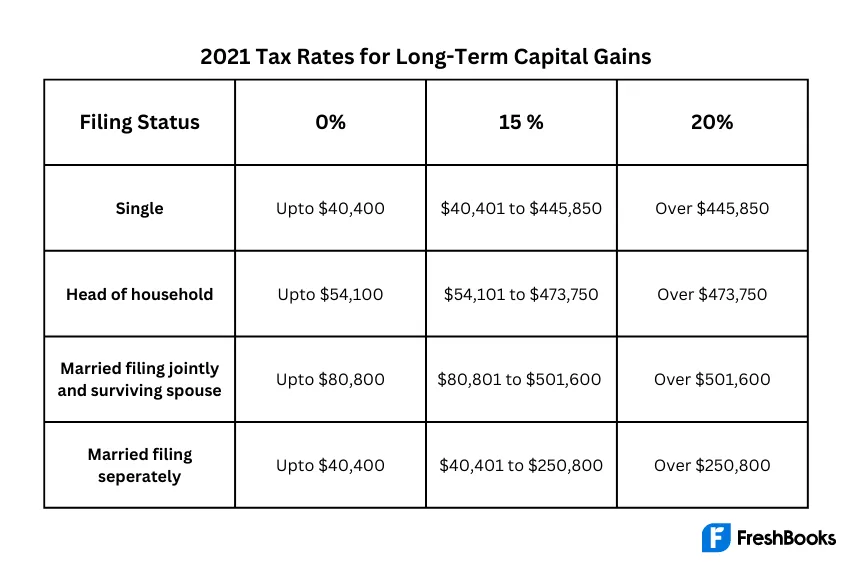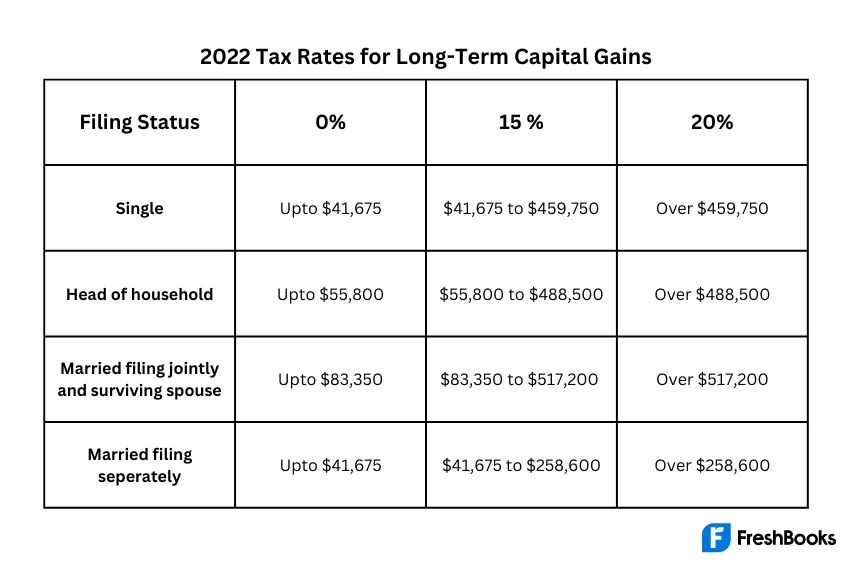Capital Gains Tax: Definition & Calculation
No matter the type of investment, you invest to make a positive return. But knowing when to cash out or sell an investment can be a delicate balance. Do you stay longer and try to grow your potential profit even more? Or do you sell it now to benefit from the gains you have already made?
These are important questions to ask as there can be different tax implications. Capital gains tax is something investors and analysts pay close attention to. Keep reading our article to learn how it works, its rates, eligibility, and how to avoid it.
Table of Contents
KEY TAKEAWAYS
- Taxes on capital gains are only owed when an investment is sold.
- Only “capital assets,” such as stocks, bonds, jewelry, coin collections, and real estate, are subject to capital gains taxes.
- Profits from investments held for longer than a year are subject to long-term gains tax.
- Short-term gains are subject to the same taxation as an individual’s regular income. That is more than the tax on long-term gains for everyone but the wealthiest.
What Is Capital Gains Tax?
The capital gains tax is the tax applied to a seller’s profit when an investment is sold. It must be paid in the tax year when the investment is sold.
Depending on the filer’s income, the long-term capital gains tax rates for the 2021 and 2022 tax years are 0%, 15%, or 20% of the profit. Every year, the income ranges are modified.
Any investment that is owned for more than a year will result in a long-term capital gains tax obligation for the investor. Short-term capital gains tax is imposed if the investor owns the investment for six months or less. The taxpayer’s typical income band affects the short-term rate. That is a higher tax rate than the capital gains rate for everyone except for the best-income taxpayers.
Your “basis” in the asset is typically deducted from the value you receive when you sell or exchange a capital asset to determine your taxable capital gain.

What Is Short-Term Capital Gains Tax?
The selling of an asset that has been owned for less than a year results in a short-term capital gain. Short-term gains do not benefit from any special tax rates, despite the fact that long-term capital gains are often taxed more favorably than salaries or wages. They are liable for ordinary income taxes.
Short-term gains are taxable in accordance with your marginal income tax bracket like regular income. Currently, there are seven federal tax brackets in the United States, with rates ranging from 10% to 37%.
What Is Long-Term Capital Gains Tax?
When compared to selling the identical asset and realizing the gain in less than a year, the tax on a long-term capital gain is virtually always cheaper. You can reduce your capital gains tax by holding onto assets for a year or more because long-term capital gains are often taxed at a more favorable rate than short-term capital gains.
The tax treatment of long-term capital gains altered following the enactment of the Tax Cuts and Jobs Act (TCJA). Prior to 2018, long-term capital gains tax rates were closely correlated with income tax rates. For the long-term capital gains tax, the TCJA created special tax bands. Typically, these figures vary from year to year.
Capital Gains Tax Rates in 2021-2022
For taxation reasons, the profit on an item that is sold less than a year after it is bought is typically taxed as though it were wages or pay. On a tax return, such gains are included with your earned income or regular income.
In general, dividends paid by an asset, which reflect profit even though they aren’t capital gains, follow the same rules. For taxpayers in the 15% and higher tax bands in the US, dividends are taxed as regular income.
Long-term capital gains, however, are subject to a separate regime. According to a rate schedule that is based on the taxpayer’s taxable income for that year, the amount of tax payments on assets held for longer than a year and sold at a profit fluctuates.
You can choose how your profit will be taxed based on your holding period. Your holding period is the span of time between the asset’s purchase and sale.
The ordinary tax rates for 2021 to 2022 can be seen in the tables below:


You can subtract capital losses from capital gains to determine your taxable gains for the year.
If you have experienced both capital gains and losses on both short-term and long-term investments, the computation becomes slightly more difficult.
Put short-term gains and losses in one pile and long-term gains and losses in another. To determine the overall short-term gain, all short-term gains must be added up. After that, the short-term losses are added together. The long-term gains and losses are then totaled.
A net short-term gain or loss is created by balancing the short-term gains and losses. The long-term gains and losses are handled in the same way.

Capital Gains Tax Strategies
The entire profit on the investment is essentially decreased by the capital gains tax. However, there is a legal means through which certain investors can lower or even get their net capital gains taxes for the year eliminated.
Simply holding onto assets for more than a year before selling them is the most straightforward strategy. That is smart since long-term capital gains often have lower taxes than short-term gains would.
1. Employ Tax-Favored Retirement Plans
One of the numerous benefits of taking part in a retirement plan like a 401(k) or IRA is the tax-free growth of your savings from year to year. To put it another way, you can buy and sell within a retirement plan without annually losing money to Uncle Sam.
Until the money is taken from the plan, the majority of plans do not require participants to pay tax on the funds. However, regardless of the nature of the underlying investment, withdrawals are taxed as ordinary income.
The Roth IRA or Roth 401(k) is an exception to this rule because income taxes are deducted as the money is deposited into the account, resulting in tax-free eligible withdrawals.
2. Keep the Wash-Sale Rule in Mind
A tax benefit can be obtained by selling stock shares at a loss and then repurchasing the same investment. You will violate the IRS wash-sale regulation prohibiting this series of transactions if you do that in 30 days or fewer.
Any kind of significant capital gains must be reported on a Schedule D form.
3. Capitalize on Your Losses
As a result of the offset of capital gains by capital losses, the annual capital gains tax will be reduced. What happens, though, if the losses outweigh the gains?
There are two possibilities. You may deduct up to $3,000 from your income if losses outweigh gains. Any excess loss that is not used in the current year can be deducted from income to lower your future tax liability because the loss rolls over.
4. Be Mindful of Your Holding Times
To qualify for classification as a long-term capital gain, an asset must be sold more than one year and one day from the date of purchase. Check the real trading date of the transaction before selling a security that you purchased a little over a year ago. By waiting just a few days, you might be able to avoid having to classify it as a short-term capital gain.
Naturally, these timing strategies are more important for large trades than for minor ones. If you are in a higher tax bracket as opposed to a lower one, the same rules still apply.
Special Capital Gains Rates and Exceptions
You can be subject to the net investment income tax if your income is substantial.
If your modified adjusted gross income, or MAGI (not your taxable income), reaches specified thresholds, this tax imposes an additional 3.8% taxes on your investment income, including your capital gains.
These thresholds are $250,000 for married individuals filing jointly or as the surviving spouse, $200,000 for individuals filing as heads of household, and $125,000 for married individuals filing separately.
Eligibility Criteria for Capital Gains Taxes
According to current federal tax law, only earnings from the sale of assets held for more than a year are subject to the “long-term capital gains” tax rate, which is currently set at 0%, 15%, or 20% depending on the taxpayer’s tax bracket for the relevant year.
The majority of taxpayers pay a greater rate on their income than any potential long-term capital gains. Thus, they have a financial incentive to hang onto investments for at least a year in order to benefit from the lower profit tax.
Any profits made from buying and selling assets held for less than a year are not only taxed but are also taxed at a higher rate than profits made from holding assets for a longer period of time. Day traders and other individuals who benefit from the simplicity and speed of online trading should be aware of this.
How to Avoid Capital Gains Taxes
You must pay capital gains taxes on any profits from investments that you make. However, there are a variety of entirely legal strategies to reduce your capital gains taxes, including the following:
- Keep your investment in place for longer than a year. If not, the profit is considered ordinary income, which means you’ll probably have to pay more.
- Remember that you can deduct up to $3,000 worth of investment losses from your profits each year. Some investors make effective use of this information. To balance their gains for the year, for instance, they can sell a loser at the end of the year.
- If your losses are higher than $3,000, you can carry them over and subtract them from your future capital gains.
- Keep a record of any deductible costs you incur when creating or maintaining your investment. They will raise the investment’s cost basis and lower its taxable profit as a result.
Summary
Low capital gains taxes, according to their supporters, are a fantastic incentive to save money and invest it in stocks and bonds. This increasing investment drives the economy’s expansion. Businesses have the resources to grow and develop, adding to the number of jobs.
The fairness of taxing passive income at a lower rate than earned income is questioned by opponents of low capital gains rates. The tax burden is shifted to working people as a result of low stock gain taxes.

FAQS on Capital Gains Tax
The states with no additional state tax on capital gains are Alaska, Florida, New Hampshire, Nevada, South Dakota, Tennessee, Texas, Washington, and Wyoming.
Residential property gains were taxed at a basic rate of 18% for the 2020–2021 tax year, and 10% for all other assets. The higher/additional rate of CGT for residential property was 28% and 20% on all other assets in the same year. This CGT rate will not change in 2022.
Because capital gains tax lower owners’ after-tax returns, they actually raise the cost of capital for businesses. In other words, potential stockholders would be ready to pay more for fresh issues of stock if they knew they wouldn’t have to pay taxes on the growth of their assets.


Share: